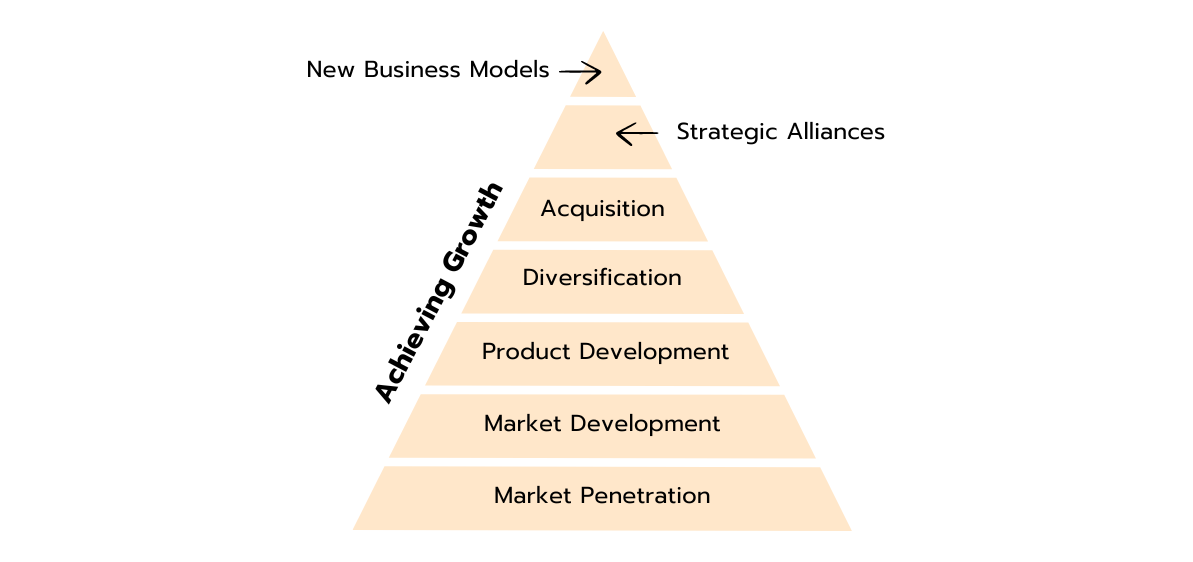The McKinsey Growth Pyramid is a strategic tool that helps businesses systematically explore growth opportunities. As the name suggests, it was developed in the 1980s by the renowned management consulting firm McKinsey & Company. It prioritizes different approaches to expansion and offers a structured roadmap for companies to increase revenue, expand their market presence, and drive long-term sustainability. This framework is widely used in consulting, including in case interviews, as it provides a clear methodology to assess how companies can scale efficiently.
McKinsey Growth Pyramid
The Seven Levels of the McKinsey Growth Pyramid
When companies seek to expand, navigating growth can be challenging, and adopting the right strategy is crucial. The McKinsey Growth Pyramid offers a framework to help businesses understand different pathways for expansion, addressing everything from deepening current market share to exploring entirely new markets and business models. Below, we break down the seven levels of the Growth Pyramid:

- Market Penetration: At its core, market penetration involves increasing the usage or sales of existing products within a company’s current markets. A practical example would be a software company that intensifies its marketing efforts to increase the usage rate of its apps. It could offer special promotions for existing customers or incentives for using additional features.
- Market Development: Market development aims to find new markets for existing products. For example, a company that manufactures children's toys might decide to market its products in a new country where it has not been present before to tap into new customer segments from there.
- Product Development: In this stage, companies develop new products for the markets in which they are already active. For example, a manufacturer of sportswear could introduce a new, innovative line of environmentally friendly, sustainable clothing to meet changing customer preferences and stand out from the competition.
- Diversification: Diversification means developing new products for new markets. A classic example is an electronics entertainment company that decides to enter the health market by developing fitness trackers. This often requires significant investments and market analysis, as it is a completely new area.
- Acquisition: Growth through acquisition can occur by purchasing another company that either operates in the same industry or offers complementary products. For example, a telecommunications provider might buy an internet service provider to expand its offerings and create synergies.
- Strategic Alliances: Strategic alliances or partnerships can also promote growth. An example would be an airline that forms an alliance with a car rental company to offer its customers a comprehensive travel package. Such collaborations can help the companies involved expand their reach and resources.
- New Business Models: Developing new business models is often the most creative and challenging growth strategy. An example would be a traditional book publisher that decides to create a self-publishing platform that allows authors to publish and market their works directly, representing a new source of revenue.
Using the McKinsey Growth Pyramid in Case Interviews
In case interviews, it is crucial that you present not only theoretical knowledge but also demonstrate how you can apply this knowledge in real business scenarios. Here are examples of how you could use each level of the Growth Pyramid in a case interview:
- Market Penetration:
Suppose you are advising a coffeehouse chain operator who wants to increase its market share in a saturated urban environment. You could suggest increasing customer frequency through loyalty programs or increasing brand awareness through targeted advertising campaigns in local media and social networks. - Market Development:
Imagine you are working on a case for a manufacturer of power tools who wants to expand into new geographic markets. You could suggest tapping into emerging markets in Asia, where the construction industry is booming, highlighting local distribution partnerships as a key strategy. - Product Development:
You are advising a company in the consumer electronics sector that wants to expand its product portfolio. One option would be to develop smart home devices that are compatible with the company's existing technology to leverage the current customer base and create added value. - Diversification:
A pharmaceutical company is looking for growth opportunities outside its core competence. You could suggest diversification into the digital health applications sector to tap into new revenue streams and reduce dependence on traditional medications. - Acquisition:
Suppose a large retail company wants to expand its online business. You could recommend acquiring an emerging e-commerce startup to gain immediate access to advanced technology and an established customer base. - Strategic Alliances:
You are working with an airline that wants to expand its market presence. A strategic alliance with a global hotel network could offer customers added value while simultaneously increasing the brand reach of both companies. - New Business Models:
A traditional book publisher wants to reinvent itself in the digital age. You could suggest introducing a subscription model for e-books that offers readers unlimited access to a wide range of titles for a monthly fee.
Each level helps outline different strategies for growth and can be used to assess a company’s approach depending on its position, market conditions, and available resources in case interviews.
The Growth Pyramid: Advantages and Disadvantages at a Glance
The McKinsey Growth Pyramid provides businesses with a structured approach to expansion, from deepening market penetration to diversifying into new sectors. Each level of the pyramid presents distinct strategies, tailored to different business needs, levels of risk, and potential rewards. By fully grasping these strategies, companies can effectively position themselves to seize opportunities and drive sustainable growth. However, it’s crucial to apply the pyramid with an awareness of its limitations, particularly in dynamic and complex markets.
Advantages:
- Comprehensive Framework: Covers all major growth strategies, helping companies evaluate various growth avenues beyond just market share expansion.
- Adaptability: Applicable across different industries, markets, and stages of business growth.
- Strategic Clarity: Clearly distinguishes between different growth approaches, making decision-making more informed and systematic.
- Risk Assessment: Offers a balance between safer options like market penetration and riskier strategies like diversification.
- Focus on Execution: Not only promotes strategic planning but also highlights the importance of execution through tactics like acquisitions and partnerships.
Disadvantages:
- Over-Simplification: It may not capture the complexity of certain industries or competitive landscapes.
- Over-Reliance: Might overlook other important strategies such as cost-cutting or consolidation.
- Risk of Misapplication: Diversification and new business models are highly risky and resource-intensive, which can lead to failure if not applied properly.
- Limited External Focus: Primarily concentrates on internal growth without accounting for external factors such as regulatory changes or geopolitical risks.
- Challenges in Fast-Changing Markets: The structured approach may lack the agility required for success in rapidly evolving environments.
In summary, while the McKinsey Growth Pyramid is a valuable tool for growth strategy, its application must be contextualized within the specific business environment and market conditions. Being aware of its strengths and limitations can help companies leverage its benefits while avoiding potential pitfalls.
Key Takeaways - Growth Strategies with the McKinsey Pyramid
The McKinsey Growth Pyramid provides a comprehensive framework that covers a variety of growth strategies, from low-risk approaches such as market penetration to high-risk options such as diversification. It is characterized by its adaptability and can be used for both start-ups and large companies in different industries. Thanks to its clear structure, it offers valuable support in prioritizing growth strategies and in decision-making processes. However, the focus on resource-intensive strategies such as acquisitions can simplify the complexity of dynamic markets and neglect external factors. Despite these limitations, the McKinsey growth pyramid remains a powerful tool for analyzing growth options, but should be used with caution to avoid overemphasizing risky or resource-intensive strategies.

